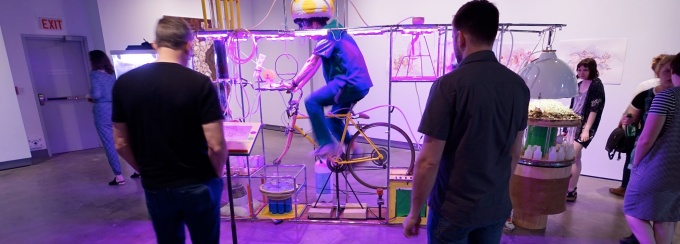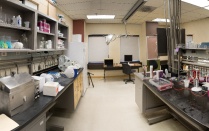IN THE NEWS
Chris Copeland and Josh Archer

Metabolic Raceway
Metabolic Raceway is an investigation into the unique history of the bacteria Pseudomonas Putida NRRL-B5473, and its importance to the fields of bioremediation and genetic engineering. P. Putida was engineered by Ananda Chakrabarty in the 1970’s to break down hydrocarbons more thoroughly in the case of an oil spill. After having his patent initially rejected, Chakrabarty successfully appealed this decision before the Supreme Court, setting a new precedent for the ownership and control of life. P. Putida was engineered for power and speed, similar to the way automobiles are engineered and marketed to consumers.
While in residence, Josh and Chris will create sculptural bioreactors made from disused automobile parts to grow engineered bioremediation bacteria. In an extremely slow but exciting race, each bioreactor will host a different bacterial strain competing to break down toxic hydrocarbons. This experiment in bioremediation begins with the question: how can cars become instruments for the remediation of their own pollution?
Chris Copeland
Through the use of simple technologies, organic materials, as well as living organisms, my sculptures and images reinterpret the ways that humans and non-humans interact on a daily basis. Industrial systems, most notably the food system, have a habit of disconnecting humans from the biological world. I raise questions about this problem to find ways that humans, non-humans, and lands can coexist. Through images, I investigate histories between humans and animals to understand how co-evolution has shaped human cultures. Crude machines in my work critique the absurd and destructive tendencies of modern technologies, while also suggesting the possibility of their positive and creative use. By working with biological materials, I challenge and complicate the assumptions of technological progress.
Josh Archer
I am an aspiring eco artist, sculptor, remediator and reverse alchemist. In Connecticut where I was born and raised, I was intensely fascinated with living organisms. My sister once showed me how to sing to snails, slowly enticing them out of their shells. I believe in the intelligence of living systems, interconnected ecologies, and biodiversity as more than a measure of environmental sustainability, but as the excitement of life. I create artworks that expand and explore our connection to the environment, whether urban, rural, agricultural, or industrial. I reject the ideological separation of humanity from nature. I believe they are not distinct but one and the same, in near infinite complexity. I am currently working to invigorate mycoremediation strategies in industrial areas in ways that reinterpret narratives and practices of industrial production. Only through coming into commonality and understanding with all the living organisms that sustain life on this planet can we appropriately address the severity of the issues that face us.

